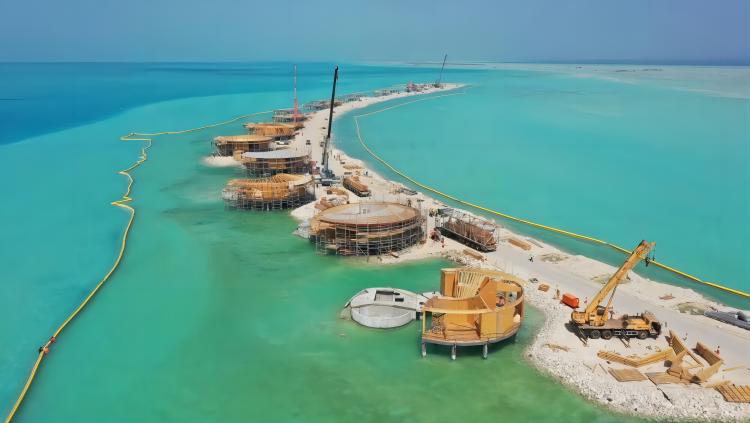Green development
The Red Sea project in Saudi Arabia practices green development concept
The Red Sea project in Saudi Arabia, which was built by CRBC, a subsidiary of CCCC, has practiced the green development concept featuring the harmonious coexistence of man and nature, contributing more Chinese wisdom and Chinese power to the green and sustainable development of Saudi Arabia's economy.

The project is located in the western part of the country along the Red Sea coast, and the project plans to turn the areas of Umluj and Al Wajhin in Tabuk province into an international tourist destination. CRBC has seven projects under construction in the region, which are located on three islands. The main work is environmental improvement, piling construction of a hotel, access channel dredging, etc.
In the Red Sea project, CRBC has taken the implementation of environmental protection measures and protection of the unique marine ecosystem of the Red Sea as a key in implementing the project, selecting technical solutions, organizing construction resources and site management, which has effectively protected the local environment while completing the project with high quality. The project has been highly recognized and praised by the owner.
In the marine ecosystem, coral reefs are the most diverse and fragile part. The coral reef complex in the Red Sea is the most abundant and densely populated coral reef complex in the Western Indian Ocean, with about 70 species of corals living the project area.
The project department established two protective curtains around the islands to minimize the construction impact on the environment. The project department set the area within 10 meters close to the coral reef as a protection zone. If the project department needs to carry out temporary backfilling, excavation and dredging of construction waters and other operations that may make the water turbid, the continuous and closed anti-fouling curtain needs to be installed and direct backfilling of untreated earth into the sea is prohibited. No navigation zone and no anchor zone are set in the area where the coral reef is located to prevent direct damage to the seabed and water.

To ensure that the water quality meets the survival conditions of corals, the project department tool various means to monitor the water quality and hired a third party to provide environmental monitoring services.
At the same time, the project department avoided coral's spawning period and sea turtle's nesting season to maximize the protection of marine life.
For all kinds of seabirds inhabiting on the island, before each new construction area is opened, the project department will learn about the location and number of birds and bird eggs in advance, and those that affect the construction will be transferred by professionals safe places; for those outside the construction area that cannot be transferred, a buffer area will be set to avoid disturbance to them.
In addition, the project department actively participated in the work related to the owner's certification for green energy and pioneering environmental design, mainly focusing on three aspects: soil erosion prevention, construction waste management, and low-carbon emission/environment-friendly materials to ensure energy-saving and low-carbon management.
As the project department continues to implement environmental protection measures, the natural environment of corals and the intertidal zone near the construction area has been well protected, and a large number of marine mammals have been attracted to the project area. In response to the visits of the marine mammals in the surrounding area and the presence of dolphins, turtles, and other organisms in the waterway, the project department conducted special training for the operation teams, and trained the captain and crew on the procedures for getting along with marine organisms to avoid any harm to them.

